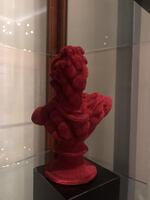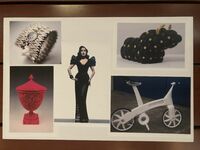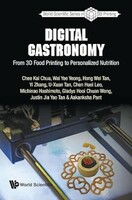-
 Apollo
Apollo 5 x 3 x 3 in
-
 Element in computer animation, Beam Me Up
Element in computer animation, Beam Me Up
-
 Architectural interpretation from Bathala Cathedral, Portugal
Architectural interpretation from Bathala Cathedral, Portugal
-
 A page in "3D Printing for Artists, Designers and Makers" by Stephen Hoskins
A page in "3D Printing for Artists, Designers and Makers" by Stephen Hoskins Clockwise beginning at lower right:
EADS, ‘Airbike’ White Nylon Bike, 2011.
Dita Von Tess, 3D printed Dress. Albert Sanchez Photography and
Michael Schmidt.
Michael Eden, ‘Wedgewood’t Tureen, Pink’. © Michael Eden.
Marianne Forrest, Silver Sliver, © Marianne Forrest 2016.
Jonathan Monaghan, Recumbent Bull, powder coated aluminum, 3D
printed steel, 6.5 x 14.5 x 6.5 inches / 16.5 x 36.8 x 16.5 cm.
Courtesy of Bitforms Gallery, New York
-
 Mastering 3D Printing: A Guide to Modeling, Printing, and Prototyping
Mastering 3D Printing: A Guide to Modeling, Printing, and Prototyping Get the most out of your printer, including how to design models, choose materials, work with different printers, and integrate 3D printing with traditional prototyping to make techniques like sand casting more efficient. This book is for new 3D printer owners, makers of all kinds, entrepreneurs, technology educators, and anyone curious about what you can do with a 3D printer.
In this revised and expanded new edition of Mastering 3D Printing, which has been a trusted resource through five years of evolution in the 3D printing industry, you’ll gain a comprehensive understanding of 3D printing. This book presumes no foreknowledge and describes what you need to know about how printers work, how to decide which type of printer (filament, resin, or powder) makes the most sense for you, and then how to go forward in the case of filament and resin printers.
This new edition now includes material about consumer resin printing, the evolution of lower-cost metal printing, and the plethora of both materials and applications.
-
 Digital Gastronomy: From 3D Food Printing To Personalized Nutrition (World Scientific Series In 3d Printing)
Digital Gastronomy: From 3D Food Printing To Personalized Nutrition (World Scientific Series In 3d Printing) The food industry has seen many changes over the last several decades — new technologies have been introduced into the way we cook, manufacture, and present food products to consumers. Digital gastronomy, which combines new computational abilities such as three-dimensional (3D) printing with traditional food preparation, has allowed consumers to design and manufacture food with personalized shapes, colours, textures, and even nutrition. In addition to the personalization of food, 3D printing of food has other advantages such as promoting automation in food preparation and food sustainability through 3D-printed cell-based meats and alternative proteins. Entire meals can be constructed just by 3D food printing alone. In this textbook, the background, principles, commercial food printers, materials, regulations, business development, as well as the emerging technologies and future outlook of 3D food printing are explored. In terms of 3D-printed materials, four main classes are reviewed: namely, desserts / snacks (comprising dairy products, chocolate, sugars, and dough), fruits / vegetables, meats /alternative proteins, and pharmaceuticals / nutraceuticals. This textbook has been written to offer readers keen to learn more about 3D food printing in terms of concepts, processes, applications, and developments of 3D food printing. No prior knowledge is required. At the end of each chapter, a set of problems offers undergraduate and postgraduate students practice on the main ideas discussed within the chapter. For tertiary-level lecturers and university professors, the topic on 3D food printing can be associated to other subjects in food and nutrition, pharmaceutical and nutraceutical sciences, and food engineering.
-
 Makerspaces in Practice: Successful Models for Implementation
Makerspaces in Practice: Successful Models for Implementation According to a Library Journal survey, 89 percent of public libraries now offer maker programming. And they're increasingly popular at academic and school libraries too. More than a decade since they first began to crop up they continue to transform and revitalize libraries, tapping into patron creativity and fostering collaboration. In this follow-up to her bestselling The Makerspace Librarians Sourcebook, Kroski gathers trailblazers of the maker movement to share their experiences and success stories. This volume is packed with programs and ideas you’ll be excited to implement at your own library. Learn what’s working (and what’s not) through first-hand perspectives on such topics as:
- survey results showing the most popular makerspace programs;
- 6 common makerspace challenges and the solutions to meet them;
- examples of successful local partnerships for public, academic, and school libraries;
- establishing norms that encourage safety and peer learning;
- meeting the needs of explorers, learners, and experts in your maker community;
- practical operational guidance, such as workflows for maintaining supplies like
scissors, glue, and 3D printer filament;
- hardware and software choices that improve accessibility;
- new developments in 3D printers and modeling software;
- cataloging and circulating maker kits for crafting, soldering, and other projects;
- budgeting tips, including how to plan for ongoing operational costs;
- measuring outcomes in public library makerspaces; and
- future developments expected for library makerspaces and equipment.
You'll be introduced to a host of tried and tested programs you can adapt for your own library, helping you support your community through making.
 Apollo 5 x 3 x 3 in
Apollo 5 x 3 x 3 in Element in computer animation, Beam Me Up
Element in computer animation, Beam Me Up  Architectural interpretation from Bathala Cathedral, Portugal
Architectural interpretation from Bathala Cathedral, Portugal  A page in "3D Printing for Artists, Designers and Makers" by Stephen Hoskins Clockwise beginning at lower right: EADS, ‘Airbike’ White Nylon Bike, 2011. Dita Von Tess, 3D printed Dress. Albert Sanchez Photography and Michael Schmidt. Michael Eden, ‘Wedgewood’t Tureen, Pink’. © Michael Eden. Marianne Forrest, Silver Sliver, © Marianne Forrest 2016. Jonathan Monaghan, Recumbent Bull, powder coated aluminum, 3D printed steel, 6.5 x 14.5 x 6.5 inches / 16.5 x 36.8 x 16.5 cm. Courtesy of Bitforms Gallery, New York
A page in "3D Printing for Artists, Designers and Makers" by Stephen Hoskins Clockwise beginning at lower right: EADS, ‘Airbike’ White Nylon Bike, 2011. Dita Von Tess, 3D printed Dress. Albert Sanchez Photography and Michael Schmidt. Michael Eden, ‘Wedgewood’t Tureen, Pink’. © Michael Eden. Marianne Forrest, Silver Sliver, © Marianne Forrest 2016. Jonathan Monaghan, Recumbent Bull, powder coated aluminum, 3D printed steel, 6.5 x 14.5 x 6.5 inches / 16.5 x 36.8 x 16.5 cm. Courtesy of Bitforms Gallery, New York Mastering 3D Printing: A Guide to Modeling, Printing, and Prototyping Get the most out of your printer, including how to design models, choose materials, work with different printers, and integrate 3D printing with traditional prototyping to make techniques like sand casting more efficient. This book is for new 3D printer owners, makers of all kinds, entrepreneurs, technology educators, and anyone curious about what you can do with a 3D printer. In this revised and expanded new edition of Mastering 3D Printing, which has been a trusted resource through five years of evolution in the 3D printing industry, you’ll gain a comprehensive understanding of 3D printing. This book presumes no foreknowledge and describes what you need to know about how printers work, how to decide which type of printer (filament, resin, or powder) makes the most sense for you, and then how to go forward in the case of filament and resin printers. This new edition now includes material about consumer resin printing, the evolution of lower-cost metal printing, and the plethora of both materials and applications.
Mastering 3D Printing: A Guide to Modeling, Printing, and Prototyping Get the most out of your printer, including how to design models, choose materials, work with different printers, and integrate 3D printing with traditional prototyping to make techniques like sand casting more efficient. This book is for new 3D printer owners, makers of all kinds, entrepreneurs, technology educators, and anyone curious about what you can do with a 3D printer. In this revised and expanded new edition of Mastering 3D Printing, which has been a trusted resource through five years of evolution in the 3D printing industry, you’ll gain a comprehensive understanding of 3D printing. This book presumes no foreknowledge and describes what you need to know about how printers work, how to decide which type of printer (filament, resin, or powder) makes the most sense for you, and then how to go forward in the case of filament and resin printers. This new edition now includes material about consumer resin printing, the evolution of lower-cost metal printing, and the plethora of both materials and applications. Digital Gastronomy: From 3D Food Printing To Personalized Nutrition (World Scientific Series In 3d Printing) The food industry has seen many changes over the last several decades — new technologies have been introduced into the way we cook, manufacture, and present food products to consumers. Digital gastronomy, which combines new computational abilities such as three-dimensional (3D) printing with traditional food preparation, has allowed consumers to design and manufacture food with personalized shapes, colours, textures, and even nutrition. In addition to the personalization of food, 3D printing of food has other advantages such as promoting automation in food preparation and food sustainability through 3D-printed cell-based meats and alternative proteins. Entire meals can be constructed just by 3D food printing alone. In this textbook, the background, principles, commercial food printers, materials, regulations, business development, as well as the emerging technologies and future outlook of 3D food printing are explored. In terms of 3D-printed materials, four main classes are reviewed: namely, desserts / snacks (comprising dairy products, chocolate, sugars, and dough), fruits / vegetables, meats /alternative proteins, and pharmaceuticals / nutraceuticals. This textbook has been written to offer readers keen to learn more about 3D food printing in terms of concepts, processes, applications, and developments of 3D food printing. No prior knowledge is required. At the end of each chapter, a set of problems offers undergraduate and postgraduate students practice on the main ideas discussed within the chapter. For tertiary-level lecturers and university professors, the topic on 3D food printing can be associated to other subjects in food and nutrition, pharmaceutical and nutraceutical sciences, and food engineering.
Digital Gastronomy: From 3D Food Printing To Personalized Nutrition (World Scientific Series In 3d Printing) The food industry has seen many changes over the last several decades — new technologies have been introduced into the way we cook, manufacture, and present food products to consumers. Digital gastronomy, which combines new computational abilities such as three-dimensional (3D) printing with traditional food preparation, has allowed consumers to design and manufacture food with personalized shapes, colours, textures, and even nutrition. In addition to the personalization of food, 3D printing of food has other advantages such as promoting automation in food preparation and food sustainability through 3D-printed cell-based meats and alternative proteins. Entire meals can be constructed just by 3D food printing alone. In this textbook, the background, principles, commercial food printers, materials, regulations, business development, as well as the emerging technologies and future outlook of 3D food printing are explored. In terms of 3D-printed materials, four main classes are reviewed: namely, desserts / snacks (comprising dairy products, chocolate, sugars, and dough), fruits / vegetables, meats /alternative proteins, and pharmaceuticals / nutraceuticals. This textbook has been written to offer readers keen to learn more about 3D food printing in terms of concepts, processes, applications, and developments of 3D food printing. No prior knowledge is required. At the end of each chapter, a set of problems offers undergraduate and postgraduate students practice on the main ideas discussed within the chapter. For tertiary-level lecturers and university professors, the topic on 3D food printing can be associated to other subjects in food and nutrition, pharmaceutical and nutraceutical sciences, and food engineering. Makerspaces in Practice: Successful Models for Implementation According to a Library Journal survey, 89 percent of public libraries now offer maker programming. And they're increasingly popular at academic and school libraries too. More than a decade since they first began to crop up they continue to transform and revitalize libraries, tapping into patron creativity and fostering collaboration. In this follow-up to her bestselling The Makerspace Librarians Sourcebook, Kroski gathers trailblazers of the maker movement to share their experiences and success stories. This volume is packed with programs and ideas you’ll be excited to implement at your own library. Learn what’s working (and what’s not) through first-hand perspectives on such topics as: - survey results showing the most popular makerspace programs; - 6 common makerspace challenges and the solutions to meet them; - examples of successful local partnerships for public, academic, and school libraries; - establishing norms that encourage safety and peer learning; - meeting the needs of explorers, learners, and experts in your maker community; - practical operational guidance, such as workflows for maintaining supplies like scissors, glue, and 3D printer filament; - hardware and software choices that improve accessibility; - new developments in 3D printers and modeling software; - cataloging and circulating maker kits for crafting, soldering, and other projects; - budgeting tips, including how to plan for ongoing operational costs; - measuring outcomes in public library makerspaces; and - future developments expected for library makerspaces and equipment. You'll be introduced to a host of tried and tested programs you can adapt for your own library, helping you support your community through making.
Makerspaces in Practice: Successful Models for Implementation According to a Library Journal survey, 89 percent of public libraries now offer maker programming. And they're increasingly popular at academic and school libraries too. More than a decade since they first began to crop up they continue to transform and revitalize libraries, tapping into patron creativity and fostering collaboration. In this follow-up to her bestselling The Makerspace Librarians Sourcebook, Kroski gathers trailblazers of the maker movement to share their experiences and success stories. This volume is packed with programs and ideas you’ll be excited to implement at your own library. Learn what’s working (and what’s not) through first-hand perspectives on such topics as: - survey results showing the most popular makerspace programs; - 6 common makerspace challenges and the solutions to meet them; - examples of successful local partnerships for public, academic, and school libraries; - establishing norms that encourage safety and peer learning; - meeting the needs of explorers, learners, and experts in your maker community; - practical operational guidance, such as workflows for maintaining supplies like scissors, glue, and 3D printer filament; - hardware and software choices that improve accessibility; - new developments in 3D printers and modeling software; - cataloging and circulating maker kits for crafting, soldering, and other projects; - budgeting tips, including how to plan for ongoing operational costs; - measuring outcomes in public library makerspaces; and - future developments expected for library makerspaces and equipment. You'll be introduced to a host of tried and tested programs you can adapt for your own library, helping you support your community through making.